Neutering your cat is an important part of being a responsible pet owner. After the procedure, you may be wondering how long your cat should wear a cone.
Also known as Elizabethan collars, cones are used to stop cats from licking or scratching at their surgery sites. It can be tricky to decide when it’s time to take it off and if there are any risks involved with leaving it on for too long.
We’ll explore the benefits of using a cone after neutering and answer the question
“How long will a cat wear a cone after being neutered?” Plus, we’ll have advice on how to make your cat comfortable while wearing one. So grab your coffee and let’s get started.
First things first
why use a cone? Neutering is an invasive procedure that requires anesthesia and stitches, so cats can potentially lick or scratch at their wound which could cause infection, or even re-open the incision site. While the cone helps heal and prevents further damage, it does not protect the area itself.
How long will your cat need to wear their cone? Generally speaking, cats should wear their cones for ten to fourteen days following surgery. However, this timeline may vary depending on your pet’s individual needs – so speak with your veterinarian for more specific instructions.
Finally, we’ll provide some tips for making life in a cone easier during recovery. From extra bedding for warmth to plenty of treats and toys for distraction – there are several ways to help ease their transition into life with a “cone head”.
What is Neutering?
Neutering is a surgical procedure that involves the removal of a cat’s reproductive organs, and it can have numerous benefits for both cats and their owners. Not only does it help to reduce the population of feral cats, but it can also help to improve a cat’s behavior and health.
If you’re thinking about having your cat neutered, it’s important to talk to your veterinarian to determine the right time for the procedure. Neutering is generally performed when cats reach sexual maturity, which can occur as early as four months old. The surgery itself involves general anesthesia and making a small incision on the scrotum or abdomen to remove the testes or ovaries. It typically takes 20 to 30 minutes and cats are usually released on the same day.
Post-operative care is crucial for ensuring that a cat heals properly after neutering. This may involve keeping them in a separate, quiet area for a few days, monitoring their incision site for signs of infection or excessive swelling, and administering pain medication as needed.
They may also be required to wear a cone or an Elizabethan collar to prevent them from licking or chewing their incision site.
The length of time they have to wear this depends on several aspects, including the surgical technique and their individual behavior.
Overall, neutering is an important step in responsible pet ownership that can help safeguard cats’ health and wellbeing in the long run.
Why Do Cats Need to Wear a Cone After Neutering?
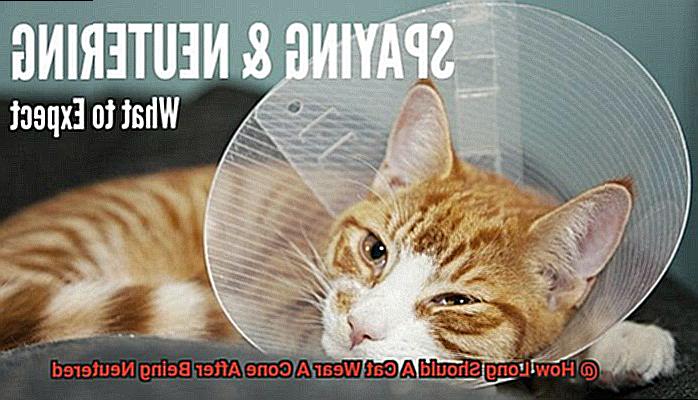
After a successful neutering procedure, your feline friend will most likely be sent home with a cone, also known as an Elizabethan collar or e-collar. This essential accessory is used to prevent your cat from licking or biting the incision site, which can cause infections, slow down the healing process, or even cause the wound to reopen.
Cats are known for their excessive grooming habits, which can lead to the removal of sutures or even infection. The cone ensures that your cat does not disrupt the healing process and that the area can be safely monitored. It may take a few days for your cat to get used to wearing it, but it is necessary for their health and well-being.
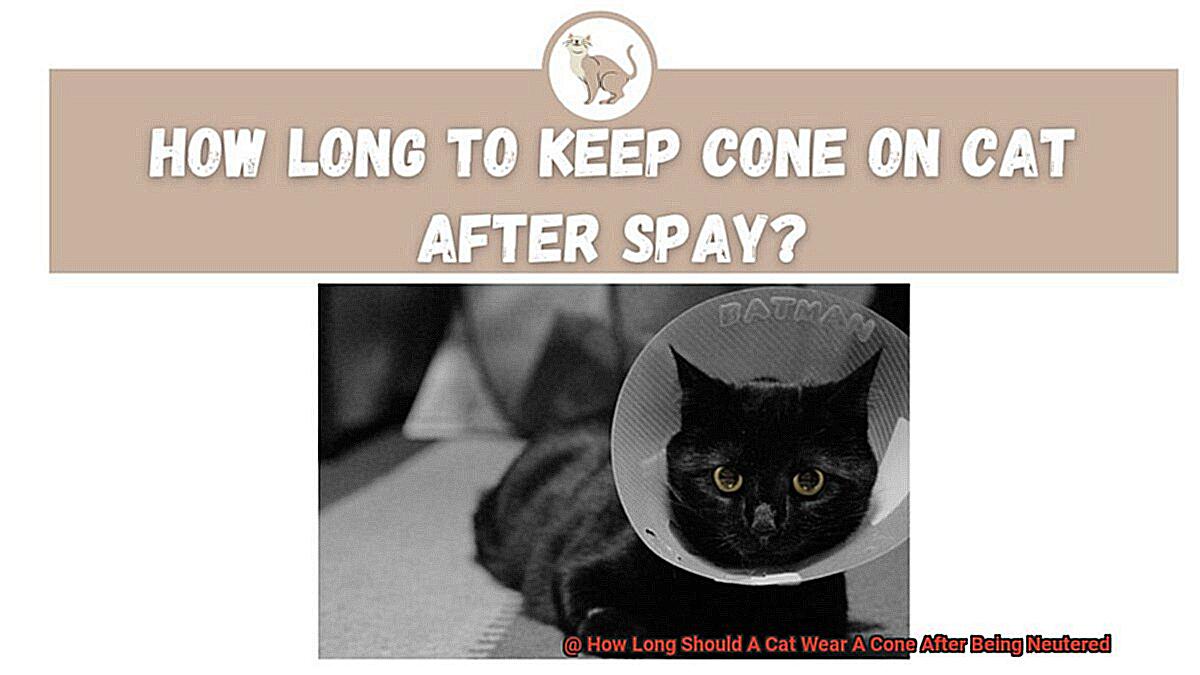
The anesthesia and surgery itself can take a toll on cats, causing disorientation, lethargy, or changes in behavior. The collar also helps protect them from accidentally bumping into things or scratching themselves, which can cause further damage or discomfort.
It is usually recommended that cats wear a cone for 10 to 14 days depending on their individual needs and healing progress. It is essential to follow your vet’s instructions and keep an eye on the incision site while the cone is still on.
If there are any signs of swelling, redness, or discharge contact your vet immediately.
How Long Should a Cat Wear a Cone After Being Neutered?
After your feline friend has been neutered, it’s essential to ensure they wear a cone or Elizabethan collar to prevent them from licking or scratching their incision site. This can lead to infections and other complications that can delay the healing process.
Generally, cats should wear a cone for 7-10 days after being neutered, but every cat is unique and may require a different timeline.
During this time, it is crucial to keep an eye on your cat’s behavior and incision site. If they are particularly active or vocal, they may need to wear the cone for longer than the recommended time frame.
Additionally, if your cat licks or scratches their incision site regularly, it could lead to infection and other problems. To be on the safe side, keep the cone on until their veterinarian approves its removal.
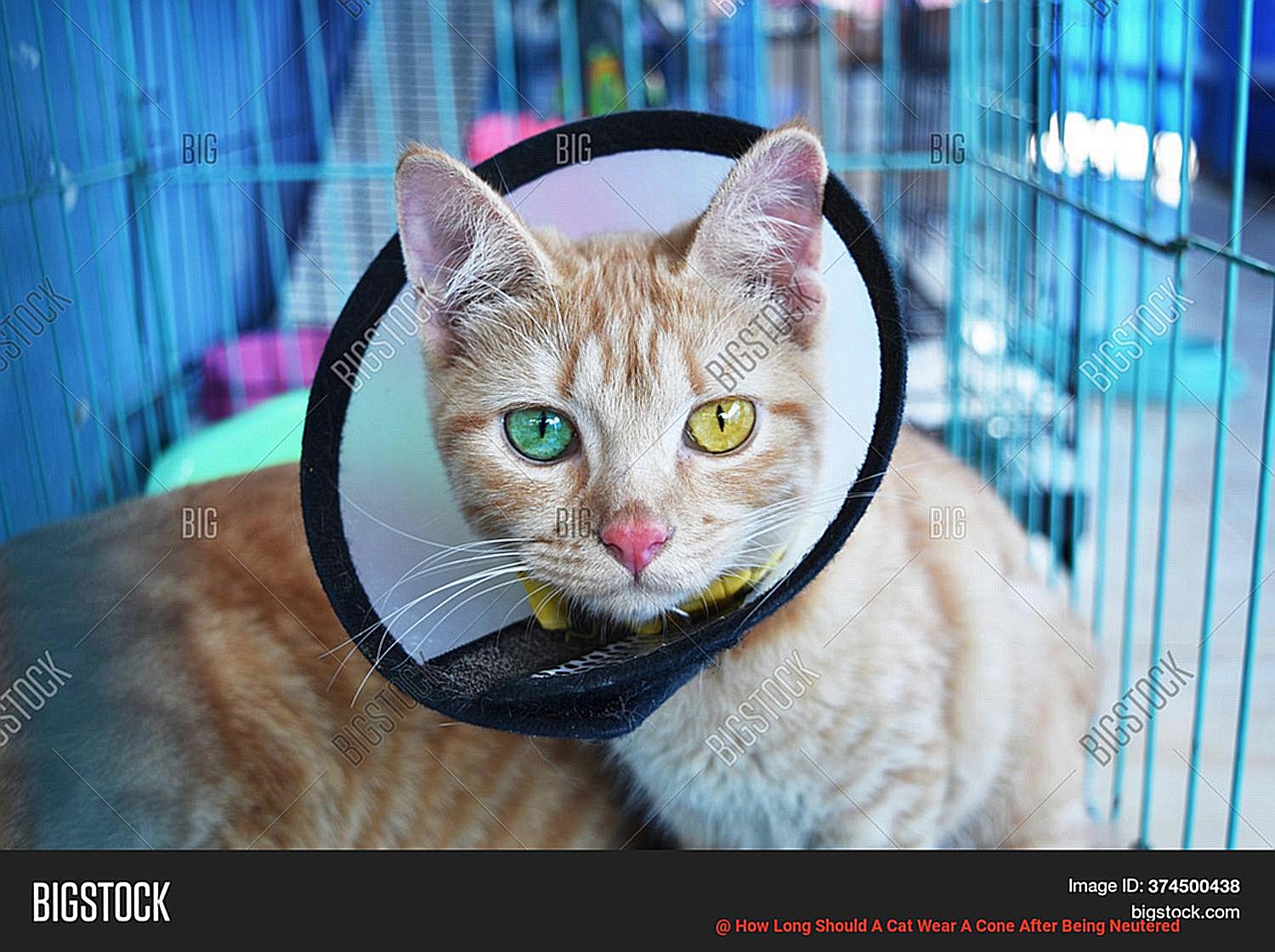
In addition to wearing a cone, there are other steps you can take to ensure your cat’s speedy recovery. Providing them with a quiet and comfortable space for rest, monitoring their food and water intake, and avoiding strenuous activities until their veterinarian approves it are all important measures you can take.
The length of time a cat should wear a cone after being neutered will vary depending on various aspects such as surgical technique and individual behavior.
Factors That Affect the Length of Time a Cat Should Wear a Cone
When it comes to determining the appropriate length of time that a cat should wear a cone after being neutered, there are several factors to consider. Age and overall health are key components in the recovery process – older cats or those with pre-existing medical conditions may require more time with the cone.
Furthermore, the size of the incision made during neutering can also affect how long your cat needs to wear the cone – smaller incisions may only need a few days with the cone, while larger ones may require up to 10 days or more.
Additionally, individual behavior can have an impact on how long your cat will need to wear a cone. Cats that are particularly active or curious may require extra time with their cone to make sure their incision site heals properly.
Lastly, the type of cone being used is also important – if your cat is uncomfortable in their new cone, you may have to switch to a different brand or modify it for improved comfort.
Ultimately, it’s best to follow your veterinarian’s advice when it comes to figuring out how long your cat should wear a cone after being neutered.
The Importance of Following the Veterinarian’s Instructions
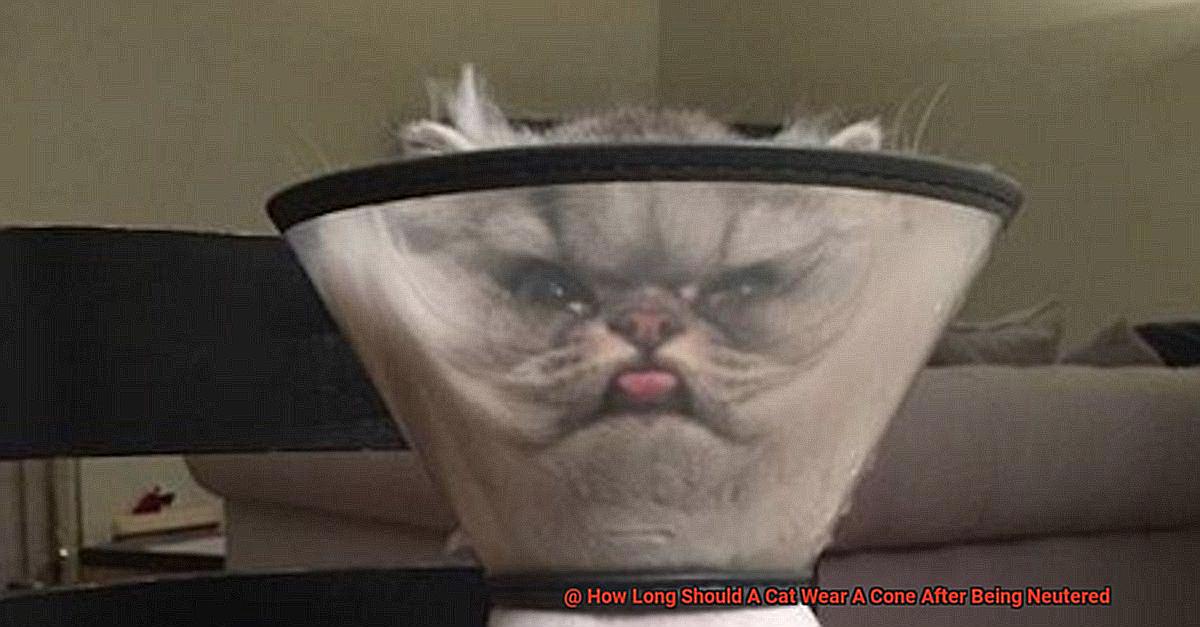
After a cat has been neutered, it is essential to follow your veterinarian’s instructions for post-operative care. This includes keeping the cone, also known as an Elizabethan collar or E-collar, on for the prescribed amount of time, usually 7-10 days.
Though it may be tempting to remove the cone early, your cat’s health and well-being depend on it.
The cone is designed to prevent your cat from licking or biting at the incision site. This can lead to infection and delay the healing process, so it is important to keep the cone on for as long as your doctor recommends.
It is also important to monitor your cat’s behavior after surgery. Changes in energy level or appetite are common and if you notice anything out of the ordinary, you should consult with your veterinarian.
Finally, make sure that the incision site is healed before removing the cone. Signs of recovery include dryness of the incision, absence of discharge or bleeding, and no redness or swelling.
Signs that the Incision Site Has Healed Properly
After a cat is spayed or neutered, it’s important to keep an eye on the incision site to make sure it is healing properly. Thankfully, there are several tell-tale signs that can help you determine if your cat’s incision is healing correctly.
The incision site should be dry and clean, with no discharge or matted fur. The skin around the area should not be red or swollen, and it should not feel warm to the touch. If any of these signs are present, contact your veterinarian right away.
If your cat’s incision appears to be healing properly, they should also not be excessively licking or scratching at the area. If this behavior continues despite using a cone or e-collar, seek professional help from your vet.
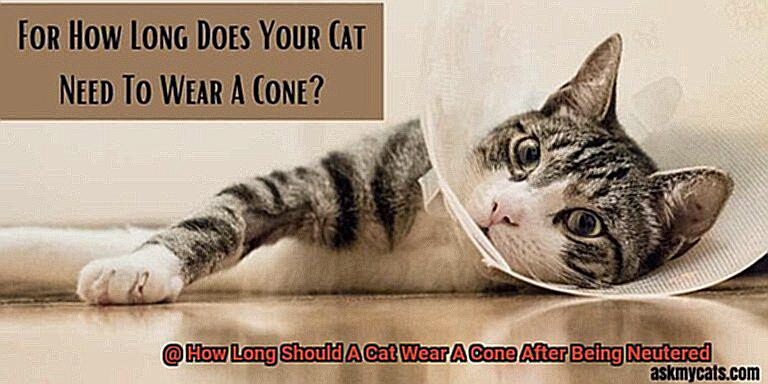
It’s also important to monitor your cat’s general behavior for signs of health and wellness. For a few days after surgery, some cats may be more lethargic than usual; however, if this persists beyond a week, contact your veterinarian for advice.
By keeping an eye out for these signs, you can rest assured that your cat’s incision is healing properly.
Lyf7l8i0LBk” >
Tips for Making Your Cat Comfortable While Wearing the Cone
After your cat has been neutered, they may be required to wear a cone to discourage them from licking or biting their incision site. This can be an uncomfortable situation for your cat, but there are ways you can make the process more bearable. Here are some tips for making your cat more comfortable when wearing the cone after being neutered.
Adjust the Cone Size
It is essential that the cone your cat is wearing is of the correct size. The cone should be snug enough to prevent your cat from reaching their incision, but not too tight that it cuts into their skin. If your cat grows or changes their fur, you may need to adjust the cone size accordingly.
Provide Comfortable Bedding
Your cat will likely spend a lot of time lying down while wearing the cone, so it’s important that they have a comfortable place to rest. Provide soft and comfortable bedding for them to lie on, and avoid bedding with loose fibers that can get caught in the cone.
Food and Water Accessibility
Wearing a cone can make it difficult for your cat to eat and drink normally. Provide your cat with elevated food and water bowls to make it easier for them to access their food and water without having to strain themselves too much. It is also important to monitor your cat’s food and water intake during this time.
Monitor Their Behavior
Even if your cat is wearing a cone, it’s still important to track their behavior for signs of discomfort or distress, such as difficulty walking or standing, excessive vocalization, lethargy, or loss of appetite. If you notice any of these symptoms, please consult your veterinarian immediately.
Give Them Breaks
Wearing a cone can be stressful and uncomfortable for your cat, so it’s important to give them breaks whenever possible by removing the cone for short periods of time while you supervise them. This will help alleviate some of their anxiety and pain from wearing the cone all day long.
Also Read: How Long to Keep a Cat Confined After Spay – 21Cats.org
Conclusion
Neutering is a responsible, long-term step to protect cats’ health and well-being. After the procedure, cats should wear a cone or Elizabethan collar for 7-10 days to prevent them from licking or scratching their incision site.
This can help avoid infection and other issues that could delay healing.
To ensure your cat’s speedy recovery, follow your veterinarian’s instructions.
Provide extra bedding for warmth, distraction with treats and toys, and monitor their behavior closely.
You may also like:
Your cat will likely spend a lot of time lying down while wearing the cone, so it’s important that they have a comfortable place to rest. Provide soft and comfortable bedding for them to lie on, and avoid bedding with loose fibers that can get caught in the cone.
Food and Water Accessibility
Wearing a cone can make it difficult for your cat to eat and drink normally. Provide your cat with elevated food and water bowls to make it easier for them to access their food and water without having to strain themselves too much. It is also important to monitor your cat’s food and water intake during this time.
Monitor Their Behavior
Even if your cat is wearing a cone, it’s still important to track their behavior for signs of discomfort or distress, such as difficulty walking or standing, excessive vocalization, lethargy, or loss of appetite. If you notice any of these symptoms, please consult your veterinarian immediately.
Give Them Breaks
Wearing a cone can be stressful and uncomfortable for your cat, so it’s important to give them breaks whenever possible by removing the cone for short periods of time while you supervise them. This will help alleviate some of their anxiety and pain from wearing the cone all day long.
Also Read: How Long to Keep a Cat Confined After Spay – 21Cats.org
Conclusion
Neutering is a responsible, long-term step to protect cats’ health and well-being. After the procedure, cats should wear a cone or Elizabethan collar for 7-10 days to prevent them from licking or scratching their incision site.
This can help avoid infection and other issues that could delay healing.
To ensure your cat’s speedy recovery, follow your veterinarian’s instructions.
Provide extra bedding for warmth, distraction with treats and toys, and monitor their behavior closely.
You may also like:
Even if your cat is wearing a cone, it’s still important to track their behavior for signs of discomfort or distress, such as difficulty walking or standing, excessive vocalization, lethargy, or loss of appetite. If you notice any of these symptoms, please consult your veterinarian immediately.







